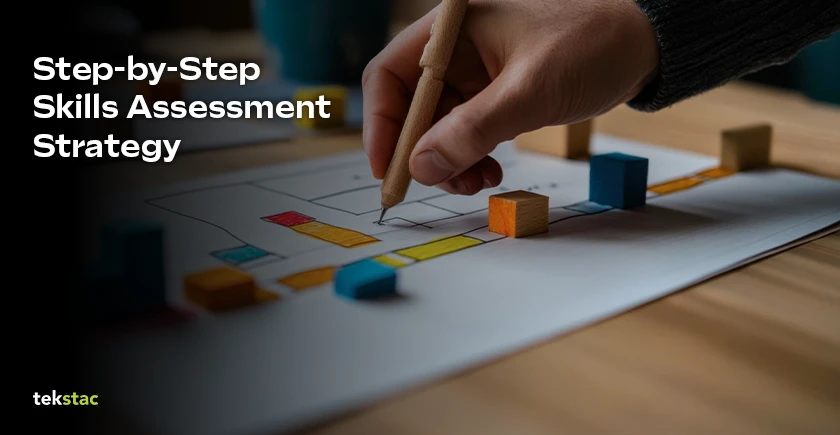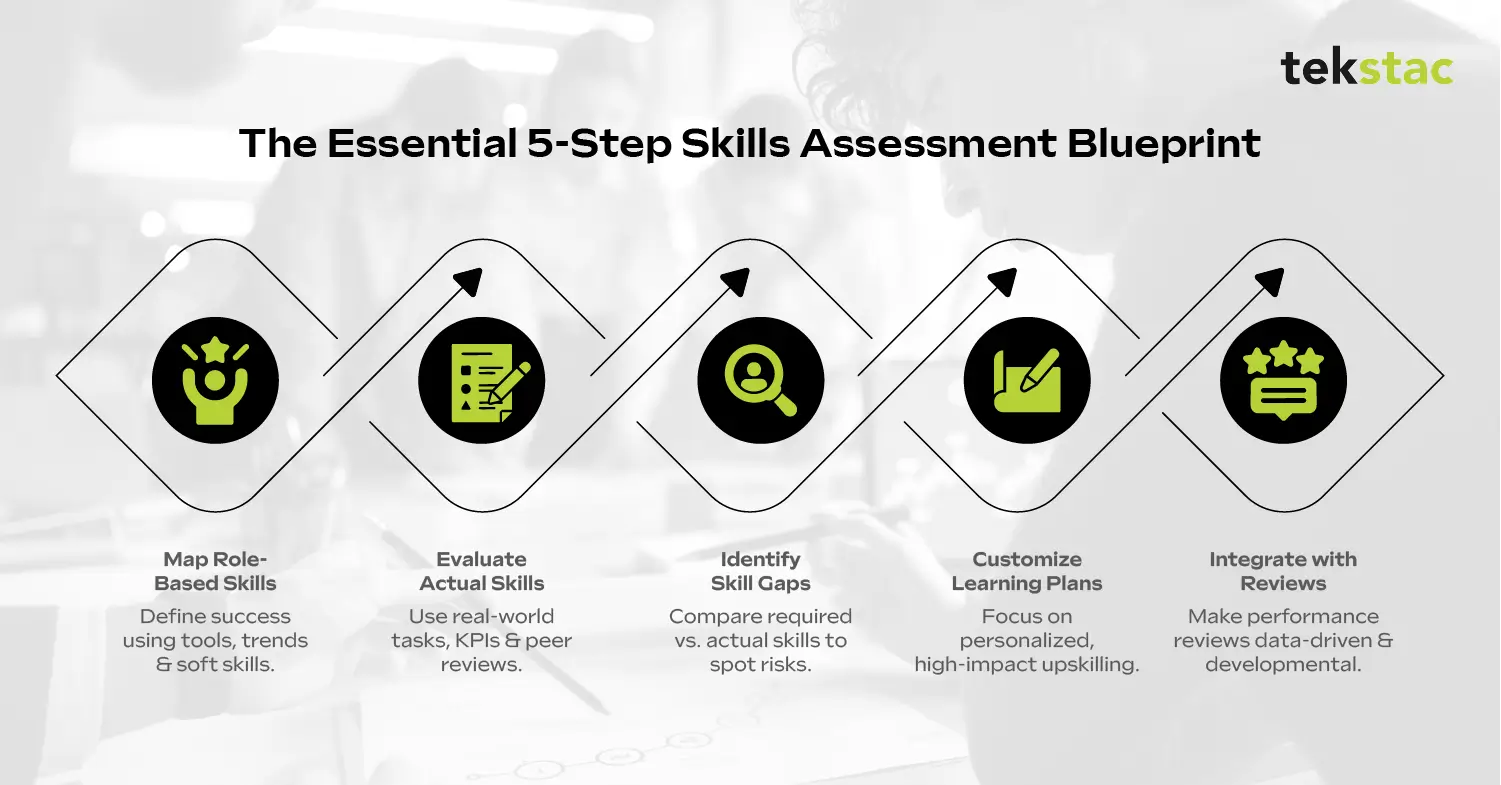Step-by-Step Guide to Conducting a Skills Assessment for Employee Training
June 20, 2025

In many organizations, productivity appears high: projects are delivered, deadlines are met, and teams stay busy. But behind this façade of activity often lies an uncomfortable question: Are people truly working in alignment with their actual skills?
The answer, more often than not, is “not really.”
Roles are frequently assigned based on resumes, past job titles, or assumed experience, not based on validated, current capabilities through a proper Skills Assessment. That’s where the inefficiencies start to creep in. Over time, these assumptions evolve into a quiet but dangerous problem: skill blindness. Our Skills Assessment Guide can help you break this cycle by identifying real skill gaps and aligning talent more effectively.
When Skill Blindness Creeps In
Without a structured Skills Assessment strategy in place, organizations end up guessing their way through talent deployment. That guesswork may hold up for a while, but eventually, it snowballs into misaligned responsibilities, inefficiencies, and burnout.
Take this example: A software development team consistently lags behind deadlines.
The assumption is they need more staff. So leadership hires aggressively. Yet the problem persists. The real issue? A misalignment between skill sets and project demands, not the headcount.
Without proper Employee skill gaps analysis, you risk:
- Promoting high performers without recognizing the full extent of their capabilities
- Letting underperformers struggle silently without targeted support
- Investing in training programs that fix the wrong problems
This leads to:
- Reactive upskilling and reskilling strategies, not proactive ones
- Employee performance reviews that lack data and meaning
- Leadership decisions based on output symptoms, not root cause analysis
Ultimately, you can’t optimize what you can’t measure. And measuring skills is the foundation for building an adaptable, competitive workforce.
Why a Structured Skills Assessment Is the Solution
To eliminate these pitfalls, companies must adopt a structured, repeatable, and data-driven Skills Assessment framework.
A robust Skills Assessment strategy provides:
- Clarity about current capabilities
- Transparency in decision-making
- Alignment between business goals and employee skill sets
- A culture of continuous learning and growth
But it’s not about generic surveys or one-time testing. True Skills Assessments are ongoing, role-specific, and aligned with real-world performance.
How to Build a Skills Assessment Process (Step-by-Step Guide)

1. Map Required Skills by Role
Start by defining what success looks like in each role.
Don’t just rely on generic job descriptions. Factor in:
- Current tools and technologies
- Industry trends and compliance requirements
- Soft skills like communication or leadership
Core technical competencies tied to business impact
2. Assess Actual Skill Levels
Assessments should be performance-based, not theoretical. Combine:
- Real-world simulations (like coding tasks or client mock calls)
- Project retrospectives
- Peer reviews
- Objective KPIs
This holistic view reveals not just what someone knows—but how they apply it.
3. Conduct an Employee Skill Gap Analysis
Once both the “required” and “actual” skill levels are clear, it’s time to identify gaps.
Ask:
- What are the top skills missing from key roles?
- How wide is the gap? (scale it numerically for prioritization)
- What business risks are associated with each gap?
Tools like Tekstac offer actionable dashboards that visualize these gaps for informed planning.
4. Tailor Upskilling and Reskilling Strategies
Use the gap data to design interventions that are:
- Specific: Tied to one skill or behavior
- Personalized: Aligned to individual learning styles and levels
- Timely: Delivered as just-in-time learning or through projects
Avoid generic training modules. Go for high-impact courses, mentorship, job rotations, or AI-driven microlearning.
5. Loop It into the Employee Performance Review Process
Instead of treating Employee performance reviews as standalone rituals, integrate updated Skills Assessment data.
This:
- Makes reviews more evidence-based
- Helps managers plan career paths
- Encourages employees to take ownership of their learning journey
With this loop in place, performance management evolves into a continuous improvement system.
Real-World Case Studies: Skills Assessment in Action
1. IBM – Building a Culture of Upskilling Through Skill Assessments
IBM implements continuous skill assessments across departments. This enables:
- Real-time tracking of skills in demand
- Targeted upskilling programs
- Enhanced internal mobility for employees based on skill readiness
The result? A future-ready, agile workforce and improved employee retention.
2. Google – Precision in Tech Hiring Through Skill-Based Evaluation
Google integrates hands-on coding assessments with interviews. This dual approach:
- Ensures practical, not just theoretical, expertise
- Reduces hiring errors
- Encourages diversity by focusing on ability over background
Google’s model highlights how customized role-specific assessments lead to better hires.
3. Amazon – Scaling Skill Validation Across Thousands of Candidates
Amazon uses data-driven, scalable skill assessments in both tech and non-tech roles. Their success lies in:
- Automating assessments at scale
- Using analytics to refine test content
- Applying assessments to both hiring and internal promotions
This has streamlined their high-volume recruitment while ensuring role alignment.
The Strategic Value of Skills Assessment
By now, it’s clear: building a Skills Assessment framework isn’t just about checking boxes, it’s about creating a high-performance learning culture.
The benefits include:
- Accurate Employee skill gap analysis
- Informed employee performance reviews
- Strategic upskilling and reskilling strategies
- A boost in retention, engagement, and innovation
Choosing the Right Tools for Skills Assessment
Effective Skills Assessment isn’t just about methodology—it’s about execution. For that, you need the right platform.
An ideal tool should offer:
- Role-based assessments for accuracy
- Real-world simulations for credibility
- Analytics and benchmarks for decision-making
- Integration with LMS and HRMS for workflow continuity
One platform that delivers across these fronts is Tekstac.
Tekstac: Your Strategic Partner in Skills Assessment
Tekstac provides a comprehensive platform designed specifically for organizations aiming to execute a structured Skills Assessment strategy. Here’s how it maps directly to your needs:
Role-Based Skill Assessments
Tekstac aligns its evaluation modules with specific job functions. This means:
- A data scientist is assessed on ML proficiency, data handling, and tool familiarity
- A sales professional is tested on objection handling, CRM use, and negotiation skills
This relevance ensures accurate insights, not guesswork.
Real-World Coding Simulations
For technical roles, Tekstac provides live coding environments that simulate real business challenges. This tests:
- Logical thinking
- Clean code principles
- Time management under pressure
Automated Grading and Benchmarking
Using smart algorithms, Tekstac automates evaluations. No more manual checks. The platform also benchmarks individual performance against:
- Team averages
- Industry norms
This lets you see exactly where your talent stands competitively.
Actionable Analytics
One of the standout features of Tekstac is its data visualization engine. Leaders get:
- Clear dashboards on skill distributions
- Heat maps of critical skill gaps
- Recommendations for learning interventions
Seamless Integration with LMS/HRMS
Tekstac doesn’t replace your existing systems—it enhances them. It can plug into:
- SAP SuccessFactors
- Workday
- Moodle
- Other enterprise LMS/HRMS platforms
This ensures that Skills Assessment becomes part of your daily workflow, not an isolated event.
Addressing Common Objections to Skills Assessment
Even when leaders understand the value, adoption of a Skills Assessment system is often delayed due to concerns. Let’s tackle them head-on.
Concern 1: “It’s Too Resource-Intensive”
Reality: While the initial investment requires time and effort, the return is exponential.
- Accurate Employee skill gap analysis reduces wasted training budget
- Productivity improves as tasks align with talent
- Turnover drops when employees feel properly utilized
Think of it as building a foundation for everything: learning, staffing, innovation.
Concern 2: “Employees Will Feel Threatened”
Reality: If framed incorrectly, yes. But the key is intentional communication.
- Emphasize growth, not judgment
- Position assessments as tools for career progression
- Highlight success stories where employees unlocked new roles due to their hidden talents
You’re building a feedback-rich culture, not a punitive one.
Concern 3: “It’ll Be Outdated Fast”
Reality: This is where tools like Tekstac excel.
Their assessment libraries can be updated regularly to reflect:
- New technologies
- Regulatory changes
- Internal strategy shifts
Additionally, since assessments are data-driven, you can adapt based on live skill evolution.
Concern 4: “Integration Will Be a Nightmare”
Reality: With modern APIs, platforms like Tekstac make integration nearly frictionless.
They offer plug-and-play compatibility with popular platforms, ensuring that:
- HR teams don’t juggle multiple tools
- Employees have a seamless experience
- Data flows directly into your performance management systems
Implementing a Continuous Skills Assessment Loop
Now that tools and objections are covered, here’s a practical execution roadmap to embed Skills Assessment into your culture.
Step 1: Start With a Pilot Program
Choose a single department (e.g., engineering or sales). Use Tekstac to:
- Run a baseline skill evaluation
- Identify critical skill gaps
- Deliver personalized training based on the results
Measure outcomes (project success, engagement scores, peer feedback) to validate the ROI.
Step 2: Align Assessments with Learning Paths
Connect results directly to upskilling and reskilling strategies. Whether you use internal academies or external platforms, make sure the learning paths solve for actual, identified gaps.
Step 3: Integrate with Performance Reviews
Bring the Skills Assessment data into regular employee performance reviews.
- Use it to validate strengths
- Create development plans with measurable milestones
- Identify high-potential employees for stretch assignments or promotions
Step 4: Scale Organization-Wide
After validating with one unit, roll out across departments.
Best practice: staggered implementation with champions from each team. This improves adoption and reduces pushback.
Long-Term Benefits: Beyond Metrics
Once fully embedded, Skills Assessments become part of your company DNA. The long-term benefits include:
- Better succession planning
- Enhanced internal mobility
- More targeted hiring
- A resilient workforce capable of shifting with the market
You also create a learning culture where development is tied to real business outcomes, not just hours logged in training portals.
Final Thoughts
In a business environment, the difference between surviving and thriving lies in your workforce adaptability. A structured Skills Assessment framework is not just a tool, it’s your organization’s compass for growth, relevance, and competitive edge.
It enables you to:
- Replace guesswork with data
- Empower employees through transparency
- Align training with real business needs
- Prepare for the future, not just react to the present
Tekstac offers a powerful, customizable engine to help you implement this vision, from employee skill gap analysis to role-specific learning. The time to move from assumptions to action is now.





